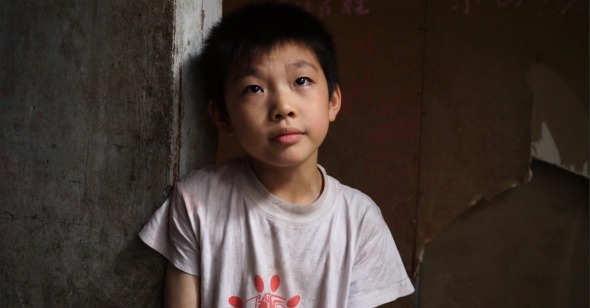Outsider Art
Chloe Lizotte on Last Days in Shibati
Last Days in Shibati plays Sunday, January 7, as part of Museum of the Moving Image’s First Look 2018.
Hendrick Dusollier travels to Chongqing, a municipality in southwestern China sprawling more than 30,000 square miles. He’s there to seek out a narrow street whose days are numbered: Shibati is the final stretch of the city’s land that hasn’t been redeveloped as part of the Chinese government’s urbanization project; its central stone staircase weaves up a leafy hill surrounded by high-rises, traffic circles, shopping centers, and jumbotrons. When broad plans for demolition are announced, Dusollier begins filming Last Days in Shibati.
Dusollier’s Chinese-language interpreter describes him to locals as a filmmaker “interested in things that are about to disappear,” which naturally leads to an interest in urban development. While his earlier shorts use 3D animations to re-create vanished cityscapes—2005’s Obras charts the development of Barcelona, while 2010’s Babel focuses on agricultural and industrial China—Last Days in Shibati takes a present-tense approach to urbanization by foregrounding the first-person experiences of the people he meets. Spanning three visits to Chongqing over the course of one year, the film focuses on three of Shibati’s residents—Zhou Hong, a seven-year-old boy; Li, a barber; and Xue Lian, a spry septuagenarian innkeeper and dumpster-diver—as they reckon with forced displacement and the dismantling of their homes and businesses. By rooting the film in individual experience, Dusollier lets Last Days in Shibati preserve the memory of a neighborhood without presuming to speak for its inhabitants.
Instead of pruning his footage into a fly-on-the-wall view of his subjects’ lives, Dusollier stresses his status as an outsider—the first words spoken in the film, “That foreigner keeps filming us,” rupture what might have been a deceptively innocuous establishing shot of a street vendor beginning to cook. Dusollier pans left to reveal a handful of men staring warily at him; they begin to berate him, essentially accusing him of making poverty porn for western audiences. “He wants to see what the migrant workers look like,” Xue Lian later speculates. Before he begins traveling with translators, the French- and English-speaking Dusollier can’t understand much of what they’re saying, and a peculiar tension develops as people allow him to film them openly mocking his background (“Maybe he’s unemployed…” / “Careful, we don’t know how much he understands”), only to be translated later in the subtitles. His footage continually emphasizes the awkwardness of his physical presence, and he never pretends that his handheld equipment allows him to blend easily into his surroundings—Xue Lian chides Dusollier that he’s carrying too much gear as he slowly eases backwards down a ladder, jolting his camera out of a composed frame.
In calling attention to his own foreign gaze, Dusollier cuts quickly through his initial impressions of Shibati to avoid lingering voyeuristically on any single person or space, and he often pointedly allows windows and doors to obstruct his views. Lengthier scenes are always predicated on direct interaction, which can even be as simple as returned eye contact—at one point, Dusollier looks back over his shoulder to hold the glance of someone he just passed, and then cuts away after an anonymous split second. This dynamic changes when Zhou Hong creeps into the edge of one of Dusollier’s frames, following him with palpable curiosity, and volunteers to take him to see the “Moonlight City”—that is, the bright lights of the Chongqing cityscape—over the hill. They bond, and when Dusollier returns to Shibati six months later, Zhou Hong introduces him to his parents; six months after that, the entire family becomes a narrative focal point as Dusollier documents their move to a government-assigned high-rise apartment.
Presented without commentary, these periodic check-ins with residents tell three personalized stories about Chongqing’s urbanization; in this way, Dusollier’s film is much like Louis Malle’s 1985 documentary God’s Country, which tracked economic decline in the agricultural American Midwest through the relationships he built there. When Dusollier returns to visit Li’s barbershop one year after they first met, he’s been forced to move his business to a different part of town, which has cost him the majority of his neighborhood clients, all of whom have similarly been dispersed across the city. Xue Lian, after holding out for as long as she can against the demolition crew, temporarily moves in with her son and salvages her favorite items from her vast outdoor garden of discarded items, including a huge fragment of a horse statue that she highlighted for Dusollier a year earlier. The object, rediscovered in the corner of an abandoned house at the edge of the city, visually encapsulates the events of the past year, yet it’s intact enough to stand apart from the images of demolition that punctuate the film.
Apart from a few forcefully contemplative minor-key guitar swells, Dusollier’s preservationist approach keeps Last Days in Shibati from romanticizing a neighborhood he’s only passing through. This chronicle of rapid transition makes an idealistic argument for film’s ability to unpretentiously revive what has been lost. And the visual contrasts of this politicized time capsule often speak loudest—its closing aerial shot of bulldozed rubble makes a strikingly anonymous break from the ground-level interaction that came before.
